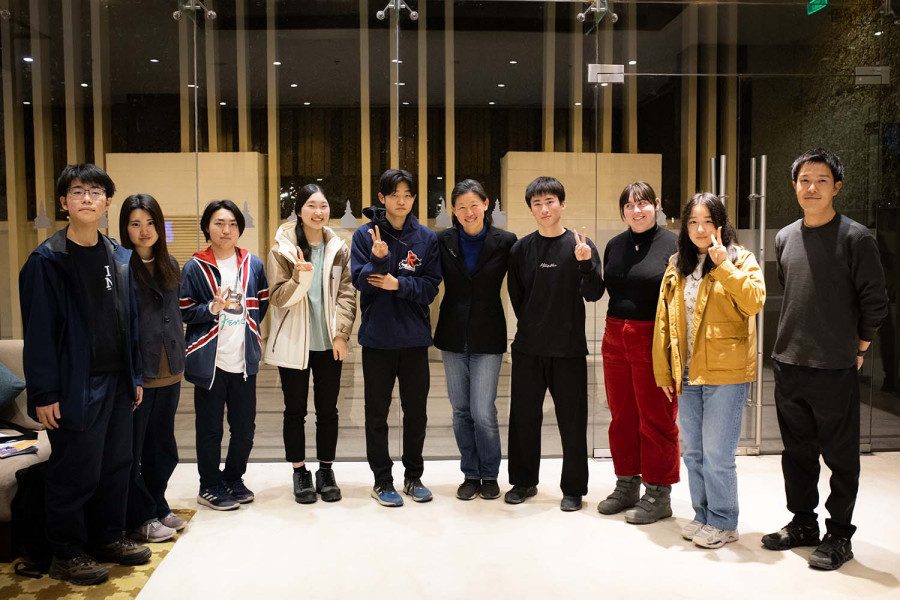Culture & Lifestyle
A transformative educational trip
Miwa Hirono, a Japanese international relations specialist and educator who recently visited Nepal with her students, shares her experience in the country and the things she has discovered on this trip.
Mimamsha Dhungel & Aashika Gautam
St. Xavier's College in Maitighar recently collaborated with Ritsumeikan University in Japan on an international relations special course. Students from Ritsumeikan's College of Global Liberal Arts (GLA), Ritsumeikan Keisho High School in Hokkaido, Japan, and St. Xavier's College in Maitighar, Nepal were all attending the course taught by Miwa Hirono, a Japanese international relations specialist and China expert. She visited Nepal on February 5 with a group of 13 students studying in Japan.
Hirono has researched and written extensively about China's participation in peacekeeping missions as well as economic development. She holds a PhD in International Relations from the Australian National University and has taught at some of the world's finest universities, including the Universities of Cambridge and Nottingham.
The Nepali students who attended Hirono’s classes were motivated by her student-centered teaching methodology. "Project-based learning was completely new to me and it felt like a breath of fresh air. Through research and discussion, I learned about foreign policies and aid in Hirono’s classes," says Biren Shrestha who studies at St. Xavier's College, Maitighar and is one of the 15 students from St. Xavier’s who recently graduated from Hirono's online course.
This was Hirono’s fourth visit to Nepal. She calls this visit more memorable and important than her previous ones because she got to participate in field visits with the students who completed the special course. Hirono also spoke at St. Xavier's College's 25th Media Talk Series, which was hosted by the college's Department of Major Arts.
Lillie Goodin, a GLA student pursuing a dual degree with the Australian National University, as well as 12 Japanese high school students and their instructor, Ryosuke Takahashi all accompanied Hirono during this trip.
Impressions of Nepal
Yamato Suzuki, a 17-year-old Keisho high school student, expresses his delight at how friendly he found Nepalis are. Another student, Mitsuki Arima, 17, feels the same way. "When we went hiking in Pokhara, many people approached and befriended us. Seeing Nepalis happy and smiling all the time delighted me," Arima says.
Goodin was taken aback when she first arrived in Nepal. This, she claims, is her first trip outside of the ‘developed’ world and it made her aware of her privileges. As a student from Australia currently studying in Japan, she has always been exposed to a systematic way of living. Nepal, on the other hand, surprised her with its spontaneity and vibrance. "It's a beautiful country to visit. Everything here is so colourful and alive which is very different from Australia or Japan where the buildings are all adorned in the same pale colours,” she says.
Socio-cultural differences between Nepal and Japan
According to Hirono, the main cultural difference is the spontaneity of Nepalis. She says that even when there are scheduling issues, Nepalis always come to a compromise and make things work. "Nepalis are always willing to help others, which is fantastic. Japanese are also very helpful and kind but Nepali culture is unique and special because it has a more laid-back approach," Hirono says.
Despite differences in archetypes, socioeconomic, and political systems, Hirono admits that Nepal and Japan have a lot in common too. One such parallel between the two countries is how deeply the citizens love, care and respect one another.
Travel experiences
Rin Kudo and Sora Aoki, who are both high school students, call their trip to Nepal ‘an incredible experience’. They seemed to have especially enjoyed the food here. "We loved momos and Dal Bhat Tarkari," Aoki exclaimed. Kudo and the other Japanese students share the same sentiment.
However, the students also faced some unpleasant situations during their stay in Nepal. Goodin recalls her bad experiences with the taxis here revealing that the taxi she got on after arriving in Nepal took her to the wrong hotel and abandoned her there. While the staff at that hotel were very kind and dropped her off at the correct location, she states that this experience made her wary of taxis in Nepal in general.
After witnessing the garbage being dumped in a landfill during this trip, Yumiko Kamishima, a 17-year-old high school student, states that she finds Nepal's waste management system problematic. "In Japan, we separate and divide waste, which is then recycled into clothes and shoes. We do not pollute the environment. It's a major issue in Nepal, and I hope it improves the next time I visit," says Kamishima. The student group also visited an NGO, Himalayan Life, in Pokhara to conduct a Fewa Lake clean-up campaign. The group also distributed brochures created by Kudo to the local hotels and shops to raise awareness on plastic bottle recycling.
Kudo and Kamishima were also surprised by the Japanese influence in Nepal. They state that they found it fascinating to see teenagers in Nepal enamored with Japanese manga, anime, J-pop, food, and fashion. "During our visit to Pokhara, two young kids told me that they grew up watching Japanese cartoons like Doraemon, which blew me away," says Kamishima.
Education
Fellow students, Akatsuki Maeda and Yamato Suzuki, were more interested in learning about the primary school system in Nepal. "We visited several schools and discovered significant differences in educational quality between public and private institutes. We also learned that brain drain and the teacher-student ratio are the two major issues in the education industry here," claims Maeda.
Hirono, however, states that she sincerely admires the educational practices of some of the institutions she visited in Nepal. The group visited a school supported by Japan International Cooperation Agency (JICA) in Bhaktapur and here Hirono learned how a lot of Nepalis leave the country to study and work abroad. She says, “This is not at all a problem. However, it is important that these valuable experiences are shared and returned to Nepal for the country’s development."
The gap between public and private schools is pretty wide in Japan too. Takahashi noticed a difference in educational attainment between the two sectors while he was working at a public school last year. He states that both nations face the problem of their students lacking the motivation to study. Institutes like Ritsumeikan Keisho High School offer things like overseas experiences, one of which is their current visit to Nepal, to encourage students to study. However, public schools do not have the resources to do this.
According to Hirono, the level of student motivation is also proportional to the teaching pedagogy. Many educational institutions use a traditional, one-way lecture format when they should really be teaching with a student-centered approach. "Students should get out of the classroom and into the real world to learn and project-based learning allows them to have a better understanding. Project-based learning helps you visualize and understand the issues you learn inside the classroom. This lets you learn and analyze a problem on the desk as if it were your own," explains Hirono, adding that education can make a difference only when it is combined with ownership and responsibility by the student.
Barriers to communication
Goodin discussed Australia's initiative to address the issue of language. Australia is geographically located in Asia, but its population is predominantly of European descent. As a result, there has always been a disconnect between where it sits in the world and how Australians relate to it.
"In order to break that down and become more inclusive and friendly with our Asian neighbors, our former prime minister, Kevin Rudd, implemented a program where every Australian primary school had to mandatorily run an Asian language course,” says Goodin explaining that students learned an Asian language in primary school, which is six years.
Learning languages helps you see the world in a different light. It entails more than just memorizing phrases as you get to learn the subtle nuances of it. Because of this, you start seeing the world through a different cultural lens too. "I believe that Japan and Nepal should implement systems like this at various levels of education to expand our knowledge of languages and break down communication barriers," suggests Goodin.
“Not that Nepalis need a big push to break the communication barriers,” says Hirono. She recalls Nepalis being friendly when the team went hiking in Pokhara. "My students were initially hesitant to talk to complete strangers but with a bit of encouragement (from me), they ended up having wonderful exchanges with the townspeople. The barrier is easily broken when you were simply willing to talk,” says Hirono emphasizing the importance of one’s willingness and eagerness to communicate with others to break down hurdles like this.




 9.88°C Kathmandu
9.88°C Kathmandu
















